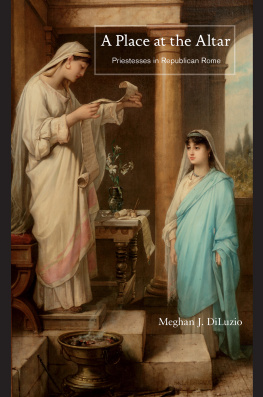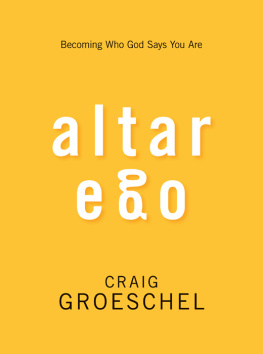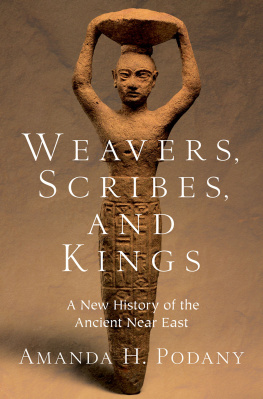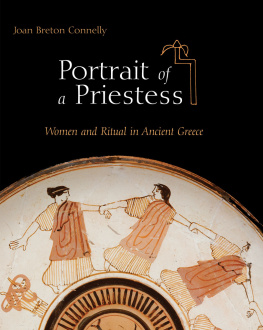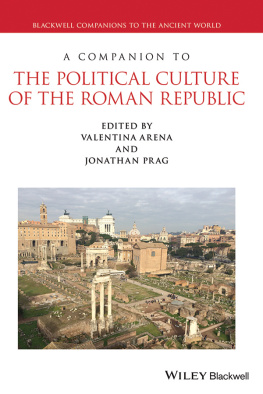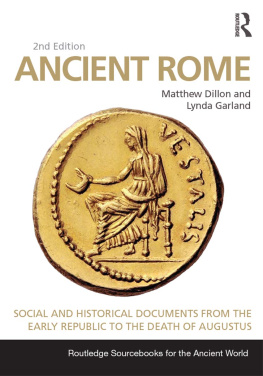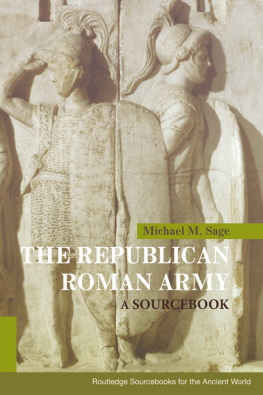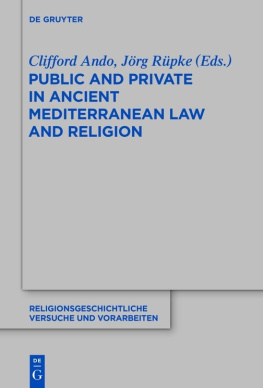
A Place at the Altar
A Place at the Altar
PRIESTESSES IN REPUBLICAN ROME
Meghan J. DiLuzio
PRINCETON UNIVERSITY PRESS
Princeton and Oxford
Copyright 2016 by Princeton University Press
Published by Princeton University Press, 41 William Street, Princeton,
New Jersey 08540
In the United Kingdom: Princeton University Press, 6 Oxford Street,
Woodstock, Oxfordshire OX20 1TR
press.princeton.edu
Jacket art: Hector Leroux (18291900), Inauguration of a Vestal Virgin, oil on canvas, 90 x 55 cm. Christies Images Limited 2012.
All Rights Reserved
Library of Congress Cataloging-in-Publication Data
Names: DiLuzio, Meghan J., 1981 author.
Title: A place at the altar : priestesses in Republican Rome / Meghan J. DiLuzio.
Description: Princeton : Princeton University Press, 2016. | Includes bibliographical references and index.
Identifiers: LCCN 2015047927 | ISBN 9780691169576 (hardcover : alk. paper)
Subjects: LCSH: Women priestsRome. | RomeReligion. | RomeReligious life and customs.
Classification: LCC BL815.W66 D55 2016 | DDC 292.6/1dc23 LC record available at https://lccn.loc.gov/2015047927
British Library Cataloging-in-Publication Data is available
This book has been composed in Minion Pro and Copperplate Gothic Std
Printed on acid-free paper.
Printed in the United States of America
1 3 5 7 9 10 8 6 4 2
FOR MY PARENTS
CONTENTS
ILLUSTRATIONS
ACKNOWLEDGMENTS
I owe a special debt to Harriet Flower, who supervised the dissertation from which this book developed. She was (and continues to be) an example to me, an ideal adviser, offering guidance and unfailing encouragement at every stage. I also owe much to the insight and enthusiasm of my readers, Denis Feeney and Michael Flower, and to the support of the faculty and my fellow graduate students in the Department of Classics at Princeton University. I first began thinking about Roman priestesses in a seminar cotaught by Michael Flower and John Gager during my first semester at Princeton. John Gager also presided over the Religion and Culture workshop at the Center for the Study of Religion, which helped to fund my final year of graduate study. I am grateful to him and to the other fellows for their comments on what eventually became of this book.
I have exceptionally fine colleagues and students in the Department of Classics at Baylor University. My life has been immeasurably enriched by the five years I have spent in their company. I am grateful to Simon Burris and Julia Dyson Hejduk, who read and commented on various portions of the manuscript, offering many helpful suggestions for improvement. Lee Ann Riccardi, who provided advice on , has been more than generous as a mentor since my days at The College of New Jersey, where I was fortunate enough to learn from other great teachers, including John Karras and David Pollio. I would also like to thank the audiences and individuals who have listened to and commented upon various aspects of this work over the years. I am particularly grateful to Jrg Rpke for discussing the project with me at an early stage, to the late Carin Green for guidance as I began the revision process, and to Katariina Mustakallio for supplying inspiration and advice as the book was nearing completion. Molly Lindner graciously shared her work in advance of publication. I am also grateful to the anonymous readers for Princeton University Press, who provided me with many useful comments. Any remaining faults and errors are strictly my own.
My research in Italy was initially made possible with funding from the Department of Classics and the Program in the Ancient World at Princeton University and subsequently through grants from the Department of Classics and the College of Arts and Sciences at Baylor University. For permission to visit and photograph various objects and monuments in Rome, I am indebted to the Soprintendenza and especially to Carlotta Caruso, Orietta Rossini, and Maurizio Rullo. I am also grateful to Filippo Merola, director of the Museo Correale di Terranova in Sorrento, and to the staff of the Greece and Rome department at the British Museum in London for their assistance and permission to study and photograph objects in their collections.
I completed the final revisions to this book during a leave generously supported by Baylor University and a fellowship from the Volkswagen Foundation. I am grateful to Volkhard Krech, director of the Kte Hamburger Kolleg at the Ruhr-Universitt Bochum, where I spent a happy and intellectually engaging year as a visiting research fellow, and to Alexandra Cuffel and Adam Knobler for their friendship and support, both in Bochum and in Ewing.
I am grateful to Rob Tempio and Sara Lerner of Princeton University Press for their help in turning my manuscript into a book, and to David Rollow for his careful copyediting. My former student Amy Welch drew was published in Gods, Objects, and Ritual Practice in Ancient Mediterranean Religion, edited by Sandra Blakely (Bristol: Lockwood Press, 2016). I wish to thank the publisher for permission to reprint it here.
My family has offered patience (often more than I deserved) and encouragement through all the years of writing. I am especially grateful to my parents, Richard and Barbara Gandy, to whom I dedicate this book. My deepest debt of gratitude is to my husband and colleague, Joseph DiLuzio, whose love and wisdom have improved every moment and every page.
ABBREVIATIONS
Ancient sources are abbreviated according to the conventions in the Oxford Classical Dictionary. All translations are my own unless otherwise noted.
BNP | Brills New Pauly: Encyclopaedia of the Ancient World, 15 vols. (Leiden, 20022010). |
CAH2 | The Cambridge Ancient History2, 14 vols. (Cambridge, 19702000). |
CCCA | M. J. Vermaseren, Corpus Cultus Cybelae Attidisque, 7 vols., tudes Prliminaires aux Religions Orientales dans lempire Romain, 50 (Leiden, 19771989). |
CIL | Corpus Inscriptionum Latinarum (Berlin, 1893). |
ILLRP | A. Degrassi, Inscriptiones Latinae Liberae Rei Publicae, 2 vols. (Florence, 19571963). |
ILS | H. Dessau, Inscriptiones Latinae Selectae2, 5 vols. (Berlin, 19541955). |
InscrIt | Inscriptiones Italiae (Rome, 1931). |
LTUR | E. M. Steinby, ed., Lexicon Topographicum Urbis Romae, 6 vols. (Rome, 19932000). |
MRR | T.R.S. Broughton, Magistrates of the Roman Republic, 3 vols. (New York, 19511986). |
OLD | P.G.W. Glare, Oxford Latin Dictionary (Oxford, 1982). |
RE | Paulys Real-encyclopdie der classischen Altertumswissenschaft (Stuttgart, 18941967). |
RRC | M. H. Crawford, Roman Republican Coinage, 2 vols. (Cambridge, 1974). |
ThesCRA | Thesaurus Cultus et Rituum Antiquorum, 8 vols. (Basel, 20042014). |
TLL | Thesaurus Linguae Latinae (Leipzig, 1900). |
A Place at the Altar
Introduction
Exegi monumentum aere perennius
regalique situ pyramidum altius,
quod non imber edax, non Aquilo impotens
Next page
